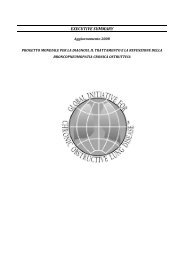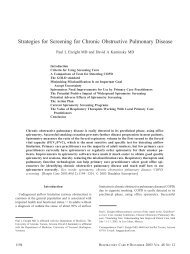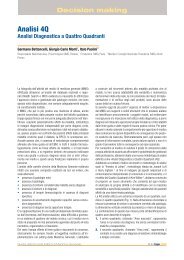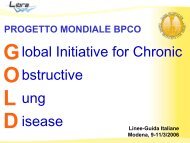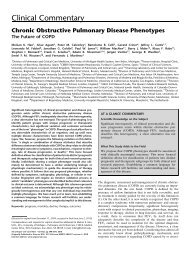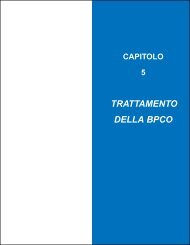Efficacy and safety of NVA237 versus placebo and ... - GOLD
Efficacy and safety of NVA237 versus placebo and ... - GOLD
Efficacy and safety of NVA237 versus placebo and ... - GOLD
You also want an ePaper? Increase the reach of your titles
YUMPU automatically turns print PDFs into web optimized ePapers that Google loves.
Eur Respir J 2012; 40: 1106–1114<br />
DOI: 10.1183/09031936.00040712<br />
CopyrightßERS 2012<br />
ERJ Open articles are open access <strong>and</strong> distributed under the terms <strong>of</strong> the Creative Commons Attribution Non-Commercial Licence 3.0<br />
<strong>Efficacy</strong> <strong>and</strong> <strong>safety</strong> <strong>of</strong> <strong>NVA237</strong> <strong>versus</strong><br />
<strong>placebo</strong> <strong>and</strong> tiotropium in patients with<br />
COPD: the GLOW2 study<br />
Edward Kerwin*, Jacques Hébert # , Nicola Gallagher " , Carmen Martin " ,<br />
Tim Overend " , Vijay K.T. Alagappan + , Yimeng Lu + <strong>and</strong> Donald Banerji +<br />
ABSTRACT: <strong>NVA237</strong> (glycopyrronium bromide) is a once-daily long-acting muscarinic antagonist<br />
(LAMA) in development for chronic obstructive pulmonary disease (COPD). The GLycopyrronium<br />
bromide in COPD airWays clinical Study 2 (GLOW2) evaluated the efficacy <strong>and</strong> <strong>safety</strong> <strong>of</strong> <strong>NVA237</strong><br />
in moderate-to-severe COPD over 52 weeks.<br />
Patients were r<strong>and</strong>omised 2:1:1 to <strong>NVA237</strong> 50 mg, <strong>placebo</strong> or open-label tiotropium 18 mg for<br />
52 weeks. Primary end-point was trough forced expiratory volume in 1 s (FEV1) at 12 weeks.<br />
1,066 patients were r<strong>and</strong>omised, 810 completed the study. At week 12, trough FEV1 increased<br />
significantly by 97 mL with <strong>NVA237</strong> (95% CI 64.6–130.2; p,0.001) <strong>and</strong> 83 mL with tiotropium (95%<br />
CI 45.6–121.4; p,0.001). Compared with <strong>placebo</strong>, <strong>NVA237</strong> produced significant improvements in<br />
dyspnoea (Transition Dyspnoea Index at week 26; p50.002) <strong>and</strong> health status (St George’s<br />
Respiratory Questionnaire at week 52; p,0.001). <strong>NVA237</strong> significantly reduced the risk <strong>of</strong><br />
moderate-to-severe COPD exacerbations by 34% (p50.001) <strong>and</strong> the use <strong>of</strong> rescue medication<br />
(p50.039), <strong>versus</strong> <strong>placebo</strong>. <strong>NVA237</strong>-<strong>placebo</strong> <strong>and</strong> tiotropium-<strong>placebo</strong> differences were comparable<br />
for all outcomes. Safety pr<strong>of</strong>iles were similar across groups.<br />
<strong>NVA237</strong> 50 mg provided significant improvements in lung function, dyspnoea, health status,<br />
exacerbations <strong>and</strong> rescue medication use, <strong>versus</strong> <strong>placebo</strong>, <strong>and</strong> was comparable to tiotropium.<br />
<strong>NVA237</strong> can potentially be an alternative choice <strong>of</strong> LAMA for COPD patients.<br />
KEYWORDS: Bronchodilator, chronic obstructive pulmonary disease, glycopyrronium bromide,<br />
long-acting muscarinic antagonist, <strong>NVA237</strong>, tiotropium<br />
Chronic obstructive pulmonary disease<br />
(COPD) is a preventable <strong>and</strong> treatable<br />
chronic disease, but is frequently underdiagnosed<br />
<strong>and</strong> under-treated in clinical practice<br />
[1, 2]. Inhaled bronchodilators, including longacting<br />
muscarinic antagonists (LAMAs), are the<br />
mainstay <strong>of</strong> the current management guidelines<br />
for COPD <strong>and</strong> are recognised to improve symptoms<br />
<strong>and</strong> health status [2].<br />
<strong>NVA237</strong> is a once-daily (q.d.) dry-powder formulation<br />
<strong>of</strong> the LAMA glycopyrronium bromide,<br />
in development for the treatment <strong>of</strong> COPD.<br />
Results from preclinical <strong>and</strong> phase II studies have<br />
demonstrated the <strong>safety</strong> <strong>and</strong> efficacy <strong>of</strong> <strong>NVA237</strong><br />
[3–7]. In a phase II study comparing the efficacy <strong>of</strong><br />
multiple doses <strong>of</strong> <strong>NVA237</strong> with <strong>placebo</strong> <strong>and</strong><br />
tiotropium 18 mg q.d. [6], <strong>NVA237</strong> 50 mg q.d. <strong>and</strong><br />
tiotropium showed comparable <strong>and</strong> statistically<br />
This article has supplementary material available from www.erj.ersjournals.com<br />
significant improvements in mean trough forced<br />
expiratory volume in 1 s (FEV1) <strong>versus</strong> <strong>placebo</strong> on<br />
days 1 <strong>and</strong> 7 (all p,0.0001). Additionally, FEV1 on<br />
day 1 was significantly higher (p,0.05) with<br />
<strong>NVA237</strong> 50 mg <strong>versus</strong> tiotropium from 5 min up<br />
to 2 <strong>and</strong> 4 h post-dose.<br />
In the phase III GLycopyrronium bromide in<br />
COPD airWays clinical study 1 (GLOW1) in<br />
patients with moderate-to-severe COPD, <strong>NVA237</strong><br />
50 mg q.d. produced rapid <strong>and</strong> significant improvementsintroughFEV1,<br />
compared with <strong>placebo</strong>,<br />
which were apparent on day 1 <strong>and</strong> sustained<br />
through week 26 [8]. Significant improvements<br />
were also observed over 26 weeks in dyspnoea<br />
measured by Transition Dyspnoea Index (TDI),<br />
health status measured by St George’s Respiratory<br />
Questionnaire (SGRQ), risk <strong>of</strong> moderate-to-severe<br />
COPD exacerbations, <strong>and</strong> rescue medication use,<br />
AFFILIATIONS<br />
*Clinical Research Institute <strong>of</strong><br />
Southern Oregon, PC, Medford, OR,<br />
<strong>and</strong><br />
+ Novartis Pharmaceuticals<br />
Corporation, East Hanover, NJ, USA.<br />
# Centre de Recherche Appliquée en<br />
Allergie de Québec, Québec, QC,<br />
Canada.<br />
" Novartis Horsham Research Centre,<br />
Horsham, UK.<br />
CORRESPONDENCE<br />
E. Kerwin<br />
3860 Crater Lake Avenue<br />
Medford<br />
OR 97504<br />
USA<br />
E-mail: ekerwin@<br />
allergyasthmaso.com<br />
Received:<br />
March 06 2012<br />
Accepted after revision:<br />
June 14 2012<br />
First published online:<br />
July 26 2012<br />
European Respiratory Journal<br />
Print ISSN 0903-1936<br />
Online ISSN 1399-3003<br />
1106 VOLUME 40 NUMBER 5 EUROPEAN RESPIRATORY JOURNAL
E. KERWIN ET AL. COPD<br />
<strong>versus</strong> <strong>placebo</strong>. <strong>NVA237</strong> was well tolerated <strong>and</strong> had an acceptable<br />
<strong>safety</strong> pr<strong>of</strong>ile, with a low incidence <strong>of</strong> typical anticholinergic<br />
adverse effects [8].<br />
Tiotropium, established as a safe <strong>and</strong> effective bronchodilator,<br />
is the only licensed LAMA available currently for COPD<br />
patients <strong>and</strong> is widely used worldwide. The objective <strong>of</strong> the<br />
phase III GLOW2 study was to evaluate the efficacy <strong>and</strong> <strong>safety</strong><br />
<strong>of</strong> <strong>NVA237</strong> 50 mg q.d. in patients with moderate-to-severe COPD<br />
compared with <strong>placebo</strong> <strong>and</strong> with tiotropium (as a reference<br />
comparator) over a longer treatment period <strong>of</strong> 52 weeks.<br />
METHODS<br />
More details are provided in the online supplement.<br />
Patients<br />
Males <strong>and</strong> females o40 yrs <strong>of</strong> age, with a smoking history <strong>of</strong><br />
o10 pack-yrs, a diagnosis <strong>of</strong> moderate-to-severe stable COPD<br />
(as defined in the 2008 Global Initiative for Chronic Obstructive<br />
Lung Disease (<strong>GOLD</strong>) guidelines) [9], post-bronchodilator FEV1<br />
o30% <strong>and</strong> ,80% <strong>of</strong> the predicted normal, <strong>and</strong> post-bronchodilator<br />
FEV1/forced vital capacity (FVC) ,0.70 were enrolled.<br />
Exclusion criteria included lower respiratory tract infection in<br />
the 6 weeks prior to screening; concomitant pulmonary disease<br />
(such as pulmonary tuberculosis or clinically significant bronchiectasis);<br />
history <strong>of</strong> asthma, malignancy <strong>of</strong> any organ system/<br />
long QT syndrome or QTc .450 ms (males) or .470 (females)<br />
at screening, symptomatic prostatic hyperplasia, bladder-neck<br />
obstruction, moderate/severe renal impairment, urinary retention,<br />
narrow-angle glaucoma, a known history <strong>of</strong> a 1 -antitrypsin<br />
deficiency; participation in the active phase <strong>of</strong> a supervised<br />
pulmonary rehabilitation programme; <strong>and</strong> contraindications for<br />
tiotropium or ipratropium or history <strong>of</strong> adverse reactions to<br />
inhaled anticholinergics.<br />
Study design <strong>and</strong> treatment<br />
This was a multicentre, double-blind, <strong>placebo</strong>-controlled with<br />
open-label tiotropium arm, parallel group study. Patients were<br />
r<strong>and</strong>omised to receive <strong>NVA237</strong> 50 mg q.d. or <strong>placebo</strong> (both<br />
delivered via a low-resistance single-dose dry-powder inhaler<br />
(the Breezhaler1 device; Novartis, Basel, Switzerl<strong>and</strong>); 50 mg<br />
refers to the quantity <strong>of</strong> the glycopyrronium moiety present in<br />
the capsule, which corresponds to a delivered dose <strong>of</strong> 44 mg),<br />
or open-label tiotropium 18 mg (delivered via the H<strong>and</strong>iHaler1<br />
device; Boehringer Ingelheim, Ingelheim, Germany) in the<br />
morning between 08:00 <strong>and</strong> 11:00 h, in a ratio <strong>of</strong> 2:1:1 for a<br />
period <strong>of</strong> 52 weeks, following a washout period (<strong>of</strong> up to<br />
7 days) <strong>and</strong> a 14-day run-in period (fig. 1).<br />
Patients were to discontinue taking long-acting bronchodilator<br />
therapy before starting the run-in period (for at least 7 days for<br />
LAMAs or 48 h for long-acting b 2 -agonists (LABAs) or LABA/<br />
inhaled corticosteroid (ICS) combinations). Patients using<br />
LABA/ICS combinations were switched to an equivalent dose<br />
<strong>of</strong> ICS as monotherapy plus salbutamol/albuterol as rescue<br />
medication for at least 48 h prior to screening. The ICS doses<br />
had to remain stable during the screening period; patients who<br />
failed screening for this reason could be re-screened if the ICS<br />
dose had been stable for 1 month. Patients were expected to<br />
remain on the same dose <strong>of</strong> ICS throughout the study.<br />
Visit 1<br />
Screening Run-in Placebo<br />
Day -21 to<br />
Day -14<br />
Visit 2<br />
Day -14 to<br />
Day -1<br />
R<strong>and</strong>omisation<br />
FIGURE 1. GLOW2 study design.<br />
52-week double-blind treatment period<br />
<strong>NVA237</strong> 50 µg<br />
Tiotropium 18 µg open-label<br />
Visits:<br />
Weeks 1, 3, 5, 9, 12, 16, 20, 26, 34, 42, 50 <strong>and</strong> 52<br />
In addition to the study treatment, concomitant medications<br />
(inhaled or intranasal corticosteroids <strong>and</strong> H1 antagonists) were<br />
permitted in patients who had been stabilised on a recommended<br />
<strong>and</strong> constant dose prior to study entry. Patients were<br />
provided with a salbutamol/albuterol inhaler to be used as<br />
rescue medication during the study.<br />
<strong>Efficacy</strong> assessments<br />
<strong>Efficacy</strong> was assessed in the full analysis set (FAS) which<br />
included all r<strong>and</strong>omised patients who received at least one<br />
dose <strong>of</strong> the study drug; patients in the FAS were analysed<br />
according to the treatment to which they were r<strong>and</strong>omised.<br />
The primary efficacy variable was trough FEV1 (defined as the<br />
mean <strong>of</strong> the 23 h 15 min <strong>and</strong> the 23 h 45 min post-dose values)<br />
following 12 weeks <strong>of</strong> treatment. Key secondary variables were<br />
dyspnoea measured using the TDI at week 26 <strong>and</strong> health status<br />
according to the total score on SGRQ at week 52. Important<br />
secondary variables were time to first moderate or severe COPD<br />
exacerbation <strong>and</strong> mean daily rescue medication use over<br />
52 weeks. Additional secondary variables included trough<br />
FEV1, trough FVC <strong>and</strong> inspiratory capacity at the end <strong>of</strong> day 1<br />
<strong>and</strong> at weeks 26 <strong>and</strong> 52, serial spirometry in a subset <strong>of</strong> patients<br />
(in study sites which had the facilities <strong>and</strong> personnel for making<br />
these measurements) on day 1 <strong>and</strong> weeks 12 <strong>and</strong> 52, <strong>and</strong> the rate<br />
<strong>of</strong> COPD exacerbations in the 52-week treatment period.<br />
Comparison <strong>of</strong> open-label tiotropium 18 mg to <strong>placebo</strong> <strong>and</strong><br />
<strong>NVA237</strong> in terms <strong>of</strong> all the end-points was also an additional<br />
variable; the study was not powered to show statistical<br />
superiority <strong>of</strong> <strong>NVA237</strong> <strong>versus</strong> tiotropium.<br />
Safety assessments<br />
The <strong>safety</strong> population included all patients who received at<br />
least one dose <strong>of</strong> the study treatment; patients were analysed<br />
according to the treatment they received. Safety was assessed by<br />
recording treatment-emergent adverse events <strong>and</strong> monitoring<br />
vital signs (pulse rate <strong>and</strong> systolic <strong>and</strong> diastolic blood pressure),<br />
<strong>and</strong> laboratory analyses (haematology, clinical chemistry <strong>and</strong><br />
urinalysis).<br />
Statistics<br />
The primary efficacy variable (trough FEV1 at week 12) was<br />
analysed using a mixed model, with treatment as a fixed effect<br />
<strong>and</strong> baseline FEV1 <strong>and</strong> FEV1 reversibility (in response to 80 mg<br />
ipratopium bromide), <strong>and</strong> baseline ICS use (yes/no) acting as<br />
c<br />
EUROPEAN RESPIRATORY JOURNAL VOLUME 40 NUMBER 5 1107
COPD<br />
E. KERWIN ET AL.<br />
covariates. To reflect the r<strong>and</strong>omisation scheme, the model also<br />
included baseline smoking status (current/ex-smoker) <strong>and</strong><br />
region as fixed effects with centre nested within region as a<br />
r<strong>and</strong>om effect.<br />
TDI <strong>and</strong> SGRQ scores <strong>and</strong> rescue use were analysed with the<br />
same mixed model as in the primary efficacy analysis, with<br />
baseline SGRQ score, baseline dyspnoea index <strong>and</strong> baseline<br />
rescue use replacing baseline FEV1 as covariates, respectively.<br />
The time to first exacerbation was displayed for each treatment<br />
group with a Kaplan–Meier curve, <strong>and</strong> analysed using a Cox<br />
regression model, which included terms for treatment, baseline<br />
inhaled corticosteroid use (yes/no), daily total symptom score,<br />
COPD exacerbation history, FEV1 reversibility, smoking history<br />
<strong>and</strong> region.<br />
RESULTS<br />
Patient disposition <strong>and</strong> baseline characteristics<br />
A total <strong>of</strong> 1,066 patients were r<strong>and</strong>omised to one <strong>of</strong> the three<br />
treatment groups in a 2:1:1 ratio (<strong>NVA237</strong>:<strong>placebo</strong>:tiotropium);<br />
76% patients completed the study (fig. 2). A higher percentage<br />
<strong>of</strong> patients in the <strong>placebo</strong> group discontinued (28.3%),<br />
compared with the patients in <strong>NVA237</strong> (22.3%) <strong>and</strong> tiotropium<br />
groups (23.1%). Baseline characteristics were broadly similar<br />
between the treatment groups (table 1). A majority <strong>of</strong> the<br />
patients had moderate COPD (64%) <strong>and</strong> ,26% <strong>of</strong> the patients<br />
had a documented history <strong>of</strong> exacerbations in the year prior to<br />
enrolment.<br />
<strong>NVA237</strong><br />
n=529<br />
Discontinued 118 (22.3)<br />
Adverse events 40 (7.6)<br />
Subject withdrew consent 40 (7.6)<br />
Unsatisfactory therapeutic effect 20 (3.7)<br />
Lost to follow-up 7 (1.3)<br />
Protocol deviation 5 (0.9)<br />
Administrative problems 4 (0.8)<br />
Death 2 (0.3)<br />
Completed 411 (77.7)<br />
Screened<br />
n=1993<br />
R<strong>and</strong>omised<br />
n=1066<br />
Discontinued 62 (23.1)<br />
Adverse events 18 (6.7)<br />
Subject withdrew consent 26 (9.7)<br />
Unsatisfactory therapeutic effect 6 (2.2)<br />
Lost to follow-up 3 (1.1)<br />
Protocol deviation 4 (1.5)<br />
Administrative problems 2 (0.7)<br />
Death 2 (0.7)<br />
Abnormal test procedure result(s) 1 (0.4)<br />
Completed 206 (76.9)<br />
Discontinued 76 (28.3)<br />
Adverse events 29 (11.0)<br />
Subject withdrew consent 23 (8.5)<br />
Unsatisfactory therapeutic effect 9 (3.3)<br />
Lost to follow-up 7 (2.6)<br />
Protocol deviation 2 (0.7)<br />
Administrative problems 1 (0.4)<br />
Death 2 (0.7)<br />
Abnormal test procedure result(s) 1 (0.4)<br />
Abnormal laboratory value(s) 1 (0.4)<br />
Completed 193 (71.7)<br />
FIGURE 2. Patient disposition.<br />
Placebo<br />
n=269<br />
Tiotropium<br />
n=268<br />
<strong>Efficacy</strong><br />
Spirometry<br />
Least squares mean (LSM) trough FEV1 at week 12 (primary<br />
end-point) was significantly higher in patients receiving<br />
<strong>NVA237</strong> 50 mg q.d. <strong>and</strong> tiotropium 18 mg q.d. compared with<br />
patients receiving <strong>placebo</strong>, with a treatment difference <strong>of</strong> 97 mL<br />
(95% CI 64.6–130.2; p,0.001) <strong>and</strong> 83 mL (95% CI 45.6–121.4;<br />
p,0.001), respectively (fig. 3). Trough FEV1 at the end <strong>of</strong> day 1<br />
<strong>and</strong> at weeks 26 <strong>and</strong> 52 in the <strong>NVA237</strong> group was significantly<br />
higher <strong>versus</strong> <strong>placebo</strong> <strong>and</strong> comparable to tiotropium (fig. 3;<br />
table 2). At the end <strong>of</strong> day 1 <strong>and</strong> at weeks 26 <strong>and</strong> 52, compared<br />
with <strong>placebo</strong>, the treatment difference in favour <strong>of</strong> <strong>NVA237</strong> was<br />
91, 134 <strong>and</strong> 108 mL, respectively (all p,0.001), while the<br />
difference in favour <strong>of</strong> tiotropium was 83, 84 <strong>and</strong> 89 mL,<br />
respectively (all p,0.001). Furthermore, at week 26, <strong>NVA237</strong><br />
significantly improved trough FEV1 by 50 mL more than<br />
tiotropium (treatment difference: 134 <strong>versus</strong> 84 mL; p,0.007).<br />
At the other time points, the improvement in trough FEV1<br />
provided by <strong>NVA237</strong> was comparable to the improvement<br />
provided by tiotropium, but the difference was not statistically<br />
significant.<br />
<strong>NVA237</strong> provided rapid bronchodilation following the first<br />
dose on day 1, with significantly higher FEV1 at all time points<br />
from 5 min to 4 h post-dose, compared with <strong>placebo</strong> (p,0.001)<br />
<strong>and</strong> with tiotropium (p,0.01; online supplement fig. S1). On<br />
day 1, the FEV1 LSM treatment difference for <strong>NVA237</strong>-<strong>placebo</strong><br />
<strong>and</strong> tiotropium-<strong>placebo</strong> was 87 <strong>and</strong> 45 mL at 5 min, respectively,<br />
<strong>and</strong> 143 <strong>and</strong> 78 mL at 15 min, respectively (all p,0.001;<br />
table 2). Peak FEV1 <strong>and</strong> FEV1 area under the curve (AUC) from<br />
0 to 4 h (AUC 0–4 h ) post-dose in the <strong>NVA237</strong> group was<br />
significantly superior to <strong>placebo</strong> <strong>and</strong> tiotropium (all p,0.001)<br />
at day 1, was significantly superior to <strong>placebo</strong> (p,0.001) <strong>and</strong><br />
tiotropium (p,0.01) at week 26, <strong>and</strong> was comparable to<br />
tiotropium at weeks 12 <strong>and</strong> 52 (table 2).<br />
The bronchodilation produced by <strong>NVA237</strong> was sustained over<br />
the 24-h period on day 1 <strong>and</strong> weeks 12 <strong>and</strong> 52, as seen in a<br />
subpopulation <strong>of</strong> patients (the serial spirometry group; n5299).<br />
FEV1 AUC 0–12 h with <strong>NVA237</strong> was significantly (p,0.001)<br />
greater than <strong>placebo</strong> at day 1 <strong>and</strong> weeks 12 <strong>and</strong> 52, significantly<br />
greater than tiotropium (p,0.05) at week 52 <strong>and</strong> comparable to<br />
tiotropium at day 1 <strong>and</strong> week 12 (table 2). FEV1 AUC 0–24 h with<br />
<strong>NVA237</strong> was significantly greater (p,0.001) than <strong>placebo</strong> at<br />
weeks 12 <strong>and</strong> 52 <strong>and</strong> significantly greater than tiotropium at<br />
week 52 (p,0.05; table 2). Serial spirometry also demonstrated<br />
significantly higher values for FEV1 throughout the 24-h periods<br />
on day 1 <strong>and</strong> at weeks 12 <strong>and</strong> 52 in patients receiving <strong>NVA237</strong>,<br />
compared with <strong>placebo</strong> (fig. 4).<br />
Inspiratory capacity was significantly higher in the <strong>NVA237</strong><br />
group <strong>versus</strong> <strong>placebo</strong> (p,0.001; except one pre-dose measurement<br />
at -20 min at week 52, p50.053), <strong>and</strong> was comparable to<br />
that in the tiotropium group, at almost all evaluated time<br />
points on day 1 <strong>and</strong> weeks 12 <strong>and</strong> 52 (online supplement table<br />
S1). Trough FVC was also significantly greater in the <strong>NVA237</strong><br />
<strong>and</strong> tiotropium patient groups <strong>versus</strong> <strong>placebo</strong> at day 1 <strong>and</strong><br />
weeks 12, 26 <strong>and</strong> 52 (p,0.001; online supplement table S2).<br />
Dyspnoea<br />
<strong>NVA237</strong> 50 mg q.d. significantly improved the TDI focal score<br />
at week 26 (2.13) compared with <strong>placebo</strong> (1.32), with a LSM<br />
1108 VOLUME 40 NUMBER 5 EUROPEAN RESPIRATORY JOURNAL
E. KERWIN ET AL. COPD<br />
TABLE 1<br />
Baseline demographics <strong>and</strong> clinical characteristics (<strong>safety</strong> population)<br />
<strong>NVA237</strong> 50 mg q.d. Placebo Tiotropium 18 mg q.d.<br />
Subjects n 525 268 267<br />
Age yrs 63.5¡9.1 63.6¡9.1 63.9¡8.2<br />
Sex<br />
Male 339 (64.6) 173 (64.6) 168 (62.9)<br />
Female 186 (35.4) 95 (35.4) 99 (37.1)<br />
Ethnicity<br />
Caucasian 459 (87.4) 236 (88.1) 232 (86.9)<br />
Black 20 (3.8) 10 (3.7) 12 (4.5)<br />
Asian 26 (5.0) 12 (4.5) 15 (5.6)<br />
Other 20 (3.8) 10 (3.7) 8 (3.0)<br />
Body mass index kg?m -2 27.9¡6.2 27.5¡6.2 27.7¡6.4<br />
Severity <strong>of</strong> COPD (<strong>GOLD</strong> 2008)<br />
Moderate 332 (63.2) 174 (64.9) 172 (64.4)<br />
Severe 187 (35.6) 92 (34.3) 94 (35.2)<br />
Very severe 6 (1.1) 2 (0.7) 0<br />
Duration <strong>of</strong> COPD yrs 7.2¡6.6 7.4¡6.6 7.5¡6.6<br />
Baseline COPD exacerbation history #<br />
0 exacerbations 377 (71.8) 206 (76.9) 195 (73.0)<br />
1 exacerbations 113 (21.5) 43 (16.0) 55 (20.6)<br />
o2 exacerbations 35 (6.7) 19 (7.1) 17 (6.4)<br />
ICS use at baseline 293 (55.8) 137 (51.1) 138 (51.7)<br />
Smoking history<br />
Ex-smoker 287 (54.7) 144 (53.7) 149 (55.8)<br />
Current smoker 238 (45.3) 124 (46.3) 118 (44.2)<br />
Duration <strong>of</strong> smoking pack-yrs 49.0¡25.4 48.0¡24.0 50.2¡28.0<br />
Patients on different COPD medications prior to start <strong>of</strong> study #<br />
LAMA 134 (25.5) 66 (24.6) 92 (34.5)<br />
LABA 58 (11.0) 38 (14.2) 25 (9.4)<br />
SABA 229 (43.9) 105 (39.2) 124 (46.4)<br />
SAMA 66 (12.6) 36 (13.4) 33 (12.4)<br />
ICS+LABA 194 (37.0) 88 (32.8) 97 (36.3)<br />
Xanthine derivatives 32 (6.1) 15 (5.6) 17 (6.4)<br />
ICS 13 (2.5) 4 (1.5) 3 (1.1)<br />
Leukotriene modifiers 4 (0.8) 7 (2.6) 3 (1.1)<br />
Pre-bronchodilator FEV1 L 1.3¡0.5 1.4¡0.5 1.3¡0.5<br />
Post-bronchodilator FEV1 L 1.5¡0.5 1.5¡0.5 1.5¡0.5<br />
Post-bronchodilator FEV1 % pred 55.7¡13.0 56.4¡14.0 56.0¡13.0<br />
Post-bronchodilator FEV1 reversibility % 16.2¡15.2 14.6¡14.5 16.4¡14.5<br />
Post-bronchodilator FEV1/FVC % 50.6¡10.5 50.9¡10.5 50.3¡10.5<br />
Data are presented as mean¡SD or n (%), unless otherwise stated. COPD: chronic obstructive pulmonary disease; <strong>GOLD</strong>: Global Initiative for Chronic Obstructive Lung<br />
Disease; ICS: inhaled corticosteroid; LAMA: long-acting muscarinic antagonist; LABA: long-acting b 2 -agonist; SABA: short-acting b 2 -agonist; SAMA: short-acting<br />
muscarinic antagonist; FEV1: forced expiratory volume in 1 s; % pred: % predicted; FVC: forced vital capacity. Pack-yrs refers to the total years <strong>of</strong> smoking multiplied by<br />
cigarette packs smoked per day. COPD exacerbation history is the number <strong>of</strong> moderate or severe COPD exacerbations in the year prior to screening. Severity <strong>of</strong> COPD is<br />
classified based on per cent predicted FEV1 <strong>and</strong> FEV1/FVC post-bronchodilation at the screening visit. Per cent predicted FEV1 is obtained as a percentage <strong>of</strong> FEV1<br />
relative to the predicted normal value. # : .1% <strong>of</strong> total patients.<br />
treatment difference <strong>of</strong> 0.81 (95% CI 0.299–1.320; p50.002). This<br />
was comparable to the improvement seen in the tiotropium<br />
group <strong>versus</strong> <strong>placebo</strong> (LSM treatment difference: 0.94, 95% CI<br />
0.356–1.521; p50.002; table 2, online supplement fig. S2a). The<br />
percentage <strong>of</strong> patients achieving a minimum clinically important<br />
difference (MCID; o1 point improvement) [10] in TDI<br />
score at week 26 was significantly higher with <strong>NVA237</strong> <strong>versus</strong><br />
<strong>placebo</strong> (55.3 <strong>versus</strong> 44.2%; OR 1.58, 95% CI 1.118–2.245;<br />
p50.01) <strong>and</strong> also with tiotropium <strong>versus</strong> <strong>placebo</strong> (53.4 <strong>versus</strong><br />
44.2%; OR 1.54, CI 1.038–2.295; p50.032) (online supplement<br />
fig. S2b). The LSM difference in TDI focal score <strong>versus</strong> <strong>placebo</strong><br />
was also significantly superior with <strong>NVA237</strong> at weeks 12 <strong>and</strong><br />
52 (p50.024 <strong>and</strong> p50.038, respectively), <strong>and</strong> with tiotropium at<br />
week 52 (p50.037; table 2).<br />
c<br />
EUROPEAN RESPIRATORY JOURNAL VOLUME 40 NUMBER 5 1109
COPD<br />
E. KERWIN ET AL.<br />
Trough FEV1 L<br />
1.55<br />
1.50<br />
1.45<br />
1.40<br />
1.35<br />
1.30<br />
1.25<br />
1.20<br />
91 mL*** 83 mL*** 97 mL*** 83 mL*** 134 mL*** ,# 84 mL*** 108 mL*** 89 mL***<br />
1.478<br />
1.388 1.372<br />
n=500n=250n=245<br />
n=513n=245n=253 n=451n=219n=233 n=416n=196n=210<br />
Day 1<br />
<strong>NVA237</strong> Placebo Tiotropium<br />
1.471 1.469<br />
Week 12<br />
Primary<br />
end-point<br />
1.455 1.458<br />
Health status<br />
SGRQ total score at week 52 was significantly improved in<br />
patients receiving <strong>NVA237</strong> <strong>and</strong> tiotropium, with a LSM treatment<br />
difference <strong>versus</strong> <strong>placebo</strong> <strong>of</strong> -3.32 (95% CI -5.287– -1.346;<br />
p,0.001) for <strong>NVA237</strong> <strong>and</strong> -2.84 (95% CI -5.105– -0.571; p50.014)<br />
for tiotropium (table 2; online supplement fig. S3). A numerically<br />
higher proportion <strong>of</strong> patients achieved the MCID in total<br />
score (o4 point reduction) [11] with <strong>NVA237</strong> (54.3%) <strong>and</strong><br />
tiotropium (59.4%) <strong>versus</strong> <strong>placebo</strong> (50.8%). The LSM treatment<br />
differences in SGRQ total score for <strong>NVA237</strong> <strong>and</strong> tiotropium<br />
<strong>versus</strong> <strong>placebo</strong> were also significant at weeks 12 <strong>and</strong> 26 (table 2;<br />
online supplement fig. S3).<br />
Exacerbations <strong>and</strong> rescue medication<br />
<strong>NVA237</strong> 50 mg q.d. significantly reduced the risk <strong>of</strong> exacerbations<br />
in terms <strong>of</strong> time to first moderate or severe exacerbation by<br />
34% compared with <strong>placebo</strong> (hazard ratio (HR) 0.66, 95% CI<br />
0.520–0.850; p50.001; number needed to treat (NNT) 13.27) over<br />
52 weeks (fig. 5). <strong>NVA237</strong> demonstrated results comparable to<br />
tiotropium which provided a 39% risk reduction <strong>versus</strong> <strong>placebo</strong><br />
(HR 0.61, 95% CI 0.456–0.821; p50.001; NNT 10.04). A 34%<br />
reduction was observed in the rate <strong>of</strong> moderate or severe COPD<br />
exacerbations in the <strong>NVA237</strong> group compared to <strong>placebo</strong> (0.54<br />
<strong>versus</strong> 0.80 per yr; rate ratio 0.66, 95% CI 0.496–0.869; p50.003).<br />
The effect <strong>of</strong> tiotropium was not significantly different from<br />
<strong>placebo</strong> (rate ratio 0.80, 95% CI 0.586–1.105; p50.179).<br />
<strong>NVA237</strong> 50 mg q.d. <strong>and</strong> tiotropium 18 mg q.d. were comparable<br />
<strong>and</strong> were both superior to <strong>placebo</strong> in reducing moderate<br />
exacerbations requiring systemic corticosteroids (<strong>NVA237</strong>/<br />
<strong>placebo</strong> OR 0.61, 95% CI 0.434–0.870; p50.006; tiotropium/<br />
<strong>placebo</strong> OR 0.62, 95% CI 0.413–0.930; p50.021) <strong>and</strong> those<br />
requiring treatment with antibiotics (<strong>NVA237</strong>/<strong>placebo</strong> OR 0.69,<br />
95% CI 0.495–0.957; p50.026; tiotropium/<strong>placebo</strong> OR 0.65, 95%<br />
CI 0.438–0.949; p50.026).<br />
The use <strong>of</strong> rescue medication was significantly lower in patients<br />
receiving <strong>NVA237</strong> <strong>and</strong> tiotropium <strong>versus</strong> those receiving<br />
1.324<br />
1.408 1.412<br />
1.303<br />
1.392<br />
Week 26 Week 52<br />
FIGURE 3. Trough forced expiratory volume in 1 s (FEV1) at day 1 <strong>and</strong> weeks<br />
12, 26 <strong>and</strong> 52. Data presented as least squares mean¡SE. ***: p,0.001 <strong>versus</strong><br />
<strong>placebo</strong>; # :p50.007 <strong>versus</strong> tiotropium.<br />
<strong>placebo</strong>, with a between group treatment difference <strong>of</strong> 0.37<br />
puffs per day (p50.039) <strong>and</strong> 0.63 puffs per day (p50.003),<br />
respectively (table 2).<br />
Safety<br />
The overall incidence <strong>of</strong> adverse events was similar across the<br />
three treatment groups (<strong>NVA237</strong> 76.6%, <strong>placebo</strong> 76.5%, tiotropium<br />
74.2%; table 3). The most frequently reported adverse<br />
event was COPD worsening, seen with a higher frequency in the<br />
<strong>placebo</strong> group (43.3%) compared to the <strong>NVA237</strong> <strong>and</strong> tiotropium<br />
groups (36.4 <strong>and</strong> 33.7%, respectively). Anti-muscarinic sideeffects,<br />
such as dry mouth, constipation, urinary retention <strong>and</strong><br />
urinary tract infections, occurred with a low frequency in the<br />
<strong>NVA237</strong>, <strong>placebo</strong> <strong>and</strong> tiotropium treatment groups.<br />
Serious adverse events occurred with a lower frequency in the<br />
<strong>NVA237</strong> group, compared with the tiotropium <strong>and</strong> <strong>placebo</strong><br />
groups (table 3). COPD exacerbation was the most common<br />
serious adverse event, occurring in 6% <strong>of</strong> <strong>placebo</strong> patients,<br />
compared to 4.9% <strong>of</strong> tiotropium <strong>and</strong> 3.6% <strong>of</strong> <strong>NVA237</strong> patients.<br />
Atrial fibrillation (AF) occurred more frequently in the <strong>NVA237</strong><br />
group compared to <strong>placebo</strong> (four patients (0.8%) <strong>versus</strong> 0,<br />
respectively); two <strong>of</strong> the four patients had a co-existing history<br />
<strong>of</strong> AF <strong>and</strong> a third patient had a history <strong>of</strong> cardiac morbidity;<br />
none <strong>of</strong> the AF events were suspected to be related to the study<br />
medication. The percentage <strong>of</strong> patients with newly occurring<br />
or worsening clinically notable QTcF values (QT interval<br />
with Fridericia’s correction) was low across treatment groups<br />
(<strong>NVA237</strong> 4.4%, tiotropium 5.3% <strong>and</strong> <strong>placebo</strong> 6%).<br />
Seven deaths were reported during the treatment <strong>and</strong> the 30-<br />
day follow-up period; three in the <strong>NVA237</strong> group (0.6%) <strong>and</strong><br />
two each in the <strong>placebo</strong> (0.7%) <strong>and</strong> tiotropium groups (0.7%).<br />
None <strong>of</strong> the deaths was suspected to be related to the study<br />
medication.<br />
DISCUSSION<br />
Results from the GLOW2 study demonstrated that once-daily<br />
<strong>NVA237</strong> 50 mg is an efficacious <strong>and</strong> safe LAMA in patients<br />
with COPD over 52 weeks <strong>of</strong> treatment, <strong>and</strong> is comparable to<br />
tiotropium, the current gold st<strong>and</strong>ard for the treatment <strong>of</strong><br />
COPD. Trough FEV1 at day 1 <strong>and</strong> at weeks 12 (primary endpoint),<br />
26 <strong>and</strong> 52 with <strong>NVA237</strong> was significantly superior<br />
<strong>versus</strong> <strong>placebo</strong>. <strong>NVA237</strong> also significantly improved dyspnoea<br />
at week 26 (mean treatment difference in TDI focal score: 0.81;<br />
p50.002), health status at week 52 (mean treatment difference<br />
in SGRQ total score: -3.32; p,0.001), <strong>and</strong> reduced the risk <strong>of</strong><br />
moderate-to-severe COPD exacerbations (p50.001) <strong>and</strong> the use<br />
<strong>of</strong> rescue medication (p50.039), <strong>versus</strong> <strong>placebo</strong>. <strong>NVA237</strong> was<br />
well tolerated, <strong>and</strong> displayed a <strong>safety</strong> pr<strong>of</strong>ile comparable to<br />
<strong>placebo</strong> <strong>and</strong> tiotropium.<br />
There is evidence to suggest that patients with COPD struggle<br />
to undertake morning activities; symptoms, particularly dyspnoea<br />
<strong>and</strong> activity limitation, are most challenging in the<br />
mornings [12]. In the GLOW2 study, <strong>NVA237</strong> provided rapid<br />
bronchodilation following the first dose on day 1; FEV1 from<br />
5 min to 4 h post-dose was significantly higher <strong>versus</strong> <strong>placebo</strong> at<br />
day 1 <strong>and</strong> also at weeks 12, 26 <strong>and</strong> 52 (p,0.001), <strong>and</strong> <strong>versus</strong><br />
tiotropium at day 1 <strong>and</strong> week 26 (p,0.05). Further, the rapid<br />
bronchodilation produced by <strong>NVA237</strong> was sustained over the<br />
24-h period on day 1 <strong>and</strong> weeks 12, 26 <strong>and</strong> 52. A rapid onset <strong>of</strong><br />
1110 VOLUME 40 NUMBER 5 EUROPEAN RESPIRATORY JOURNAL
E. KERWIN ET AL. COPD<br />
TABLE 2 Spirometry <strong>and</strong> symptom-related (dyspnoea, health status, rescue medication use) outcomes on day 1 <strong>and</strong> weeks 12,<br />
26 <strong>and</strong> 52 (full analysis set population)<br />
Treatment difference<br />
<strong>NVA237</strong>–<strong>placebo</strong> Tiotropium–<strong>placebo</strong> <strong>NVA237</strong>–tiotropium<br />
Day 1<br />
Trough FEV1 L 0.091¡0.0109*** 0.083¡0.0126*** 0.008¡0.0110<br />
FEV1 L (5 min post-dose) 0.087¡0.0081*** 0.045¡0.0093*** 0.041¡0.0081***<br />
FEV1 L (15 min post-dose) 0.143¡0.0089*** 0.078¡0.0102*** 0.065¡0.0089***<br />
Peak FEV1 L 0.200¡0.0126*** 0.152¡0.0146*** 0.047¡0.0126***<br />
FEV1 AUC 0–4 h 0.197¡0.0095*** 0.141¡0.0109*** 0.056¡0.0095***<br />
FEV1 AUC 0–12 h 0.159¡0.019*** 0.127¡0.0214*** 0.032¡0.0189<br />
Week 12<br />
Trough FEV1 L 0.097¡0.0167*** 0.083¡0.0193*** 0.014¡0.0165<br />
Peak FEV1 L 0.176¡0.0178*** 0.142¡0.0204*** 0.033¡0.0173<br />
FEV1 AUC 0–4 h 0.176¡0.017*** 0.147¡0.0194*** 0.03¡0.0165<br />
FEV1 AUC 0–12 h 0.140¡0.299*** 0.107¡0.0337** 0.034¡0.0295<br />
FEV1 AUC 0–24 h 0.106¡0.0283*** 0.079¡0.319* 0.027¡0.0278<br />
FEV1 AUC 12–24 h 0.070¡0.0292* 0.047¡0.0325 0.023¡0.0283<br />
SGRQ total score -3.17¡0.840*** -2.84¡0.967** -0.33¡0.839<br />
TDI focal score 0.60¡0.265* 0.26¡0.303 0.34¡0.257<br />
Week 26<br />
Trough FEV1 L 0.134¡0.0189*** 0.084¡0.0216*** 0.050¡0.0185**<br />
Peak FEV1 L 0.177¡0.0192*** 0.120¡0.022*** 0.057¡0.0189**<br />
FEV1 AUC 0–4 h 0.177¡0.0182*** 0.127¡0.209*** 0.05¡0.0179**<br />
SGRQ total score -3.38¡0.968*** -2.52¡1.113* -0.86¡0.964<br />
TDI focal score 0.81¡0.260** 0.94¡0.297** -0.13¡0.253<br />
Week 52<br />
Trough FEV1 L 0.108¡0.0195*** 0.089¡0.0223*** 0.019¡0.0190<br />
Peak FEV1 L 0.167¡0.0204*** 0.152¡0.0234*** 0.014¡0.02<br />
FEV1 AUC 0–4 h 0.165¡0.0198*** 0.151¡0.0227*** 0.015¡0.0194<br />
FEV1 AUC 0–12 h 0.128¡0.0327*** 0.06¡0.0374 0.068¡0.0328*<br />
FEV1 AUC 0–24 h 0.106¡0.0322*** 0.04¡0.0369 0.066¡0.0322*<br />
FEV1 AUC 12–24 h 0.083¡0.034* 0.021¡0.0389 0.062¡0.0341<br />
SGRQ total score -3.32¡1.004*** -2.84¡1.155* -0.48¡1.002<br />
Change from baseline in mean daily number <strong>of</strong> puffs <strong>of</strong> rescue medication -0.37¡0.181* -0.63¡0.209** 0.25¡0.181<br />
TDI focal score 0.57¡0.276* 0.66¡0.315* -0.08¡0.269<br />
Data are presented as least squares mean¡SE. FEV1: forced expiratory volume in 1 s; AUC: area under the curve; TDI: Transition Dyspnoea Index; SGRQ: St George’s<br />
Respiratory Questionnaire. ***: p,0.001; **: p,0.01; *: p,0.05.<br />
effect <strong>and</strong> sustained 24-h bronchodilation are important features<br />
which may have a significant positive impact on the morning<br />
routines <strong>and</strong> daily life <strong>of</strong> patients with COPD, <strong>and</strong> could<br />
potentially contribute to improving adherence to therapy.<br />
The <strong>GOLD</strong> guidelines recognise the importance <strong>of</strong> symptom<br />
reduction in the management <strong>of</strong> COPD, <strong>and</strong> the assessment <strong>of</strong><br />
symptom severity is a key element in the pharmacological<br />
management <strong>of</strong> COPD [2]. Exertional dyspnoea is one <strong>of</strong> the<br />
most distressing symptoms for patients with COPD [13]. Lung<br />
hyperinflation reduces inspiratory capacity, a measure that<br />
correlates with dyspnoea <strong>and</strong> exercise tolerance in patients<br />
with moderate-to-severe COPD [13]. In the GLOW3 study,<br />
<strong>NVA237</strong> 50 mg produced significant improvements in inspiratory<br />
capacity at isotime (defined as the last matching time<br />
point in submaximal exercise tolerance test at which for both<br />
periods the patient had a test result) at day 1, which was<br />
sustained through the study period <strong>of</strong> 3 weeks (both p,0.001)<br />
[14]. This was accompanied by an immediate <strong>and</strong> significant<br />
improvement in exercise endurance from day 1, which<br />
increased over the study period (both p,0.001). In the current<br />
GLOW2 study, the significantly greater improvement in<br />
inspiratory capacity seen with <strong>NVA237</strong> <strong>versus</strong> <strong>placebo</strong> (comparable<br />
to improvement provided with tiotropium <strong>versus</strong><br />
<strong>placebo</strong>) signifies a greater reduction in hyperinflation, which<br />
may contribute to a reduction in dyspnoea. Furthermore,<br />
<strong>NVA237</strong> produced an improvement in dyspnoea on the TDI<br />
that was superior to <strong>placebo</strong> <strong>and</strong> comparable to tiotropium at<br />
weeks 12, 26 <strong>and</strong> 52. The reduced usage <strong>of</strong> rescue medication<br />
in patients receiving <strong>NVA237</strong> compared with <strong>placebo</strong> also<br />
indicates better symptom management. This overall improvement<br />
was reflected in the SGRQ total scores which were<br />
c<br />
EUROPEAN RESPIRATORY JOURNAL VOLUME 40 NUMBER 5 1111
COPD<br />
E. KERWIN ET AL.<br />
a) 1.8<br />
1.7<br />
1.6<br />
FEV1 L<br />
b) 1.8<br />
1.7<br />
1.6<br />
1.5<br />
1.4<br />
1.3<br />
1.2<br />
0<br />
c) 1.8<br />
1.7<br />
1.6<br />
1.5<br />
1.4<br />
1.3<br />
FEV1 L<br />
FEV1 L<br />
1.5<br />
1.4<br />
1.3<br />
1.2<br />
0<br />
1.2<br />
0<br />
0 1<br />
<strong>NVA237</strong> (n=144)<br />
Placebo (n=79)<br />
Tiotropium (n=76)<br />
<strong>NVA237</strong> (n=144)<br />
Placebo (n=79)<br />
Tiotropium (n=76)<br />
<strong>NVA237</strong> (n=144)<br />
Placebo (n=79)<br />
Tiotropium (n=76)<br />
2 3 4 5 6 7 8 9 10 11 12 13 14 15 16 17 18 19 20 21 22 23 24<br />
Time post-dose h<br />
FIGURE 4. Serial spirometry on a) day 1, b) week 12 <strong>and</strong> c) week 52. a)<br />
<strong>NVA237</strong> superior to <strong>placebo</strong> at all assessed time points (p,0.01), superior to<br />
tiotropium at 5, 15 <strong>and</strong> 30 min, 1 <strong>and</strong> 2 h (p,0.05). b) <strong>NVA237</strong> <strong>versus</strong> <strong>placebo</strong> all<br />
time points statistically significant (p,0.05) except 16 h, 23 h 15 min <strong>and</strong> 23 h<br />
45 min. c) <strong>NVA237</strong> superior to <strong>placebo</strong> at all assessed time points (p,0.01),<br />
superior to tiotropium at 5 min,15 min <strong>and</strong> 30 min, <strong>and</strong> 1, 2 <strong>and</strong> 3 h (p,0.05).<br />
FEV1: forced expiratory volume in 1 s.<br />
significantly lower with <strong>NVA237</strong> <strong>and</strong> comparable to tiotropium,<br />
<strong>versus</strong> <strong>placebo</strong>, at weeks 12 <strong>and</strong> 52.<br />
COPD exacerbations reduce patients’ health status [15, 16], <strong>and</strong><br />
increase the risk <strong>of</strong> hospitalisation <strong>and</strong> death [17, 18], <strong>and</strong><br />
treatment costs [19]. Furthermore, an association has been<br />
reported between frequency <strong>of</strong> exacerbations <strong>and</strong> increased<br />
rate <strong>of</strong> lung function decline [20, 21]. Hence, prevention <strong>of</strong><br />
exacerbations <strong>and</strong> reduction <strong>of</strong> future risk should be a<br />
consideration in the management <strong>of</strong> COPD [2]. In the GLOW2<br />
study, <strong>NVA237</strong> reduced the risk <strong>of</strong> moderate-to-severe COPD<br />
exacerbations in patients with COPD by 34% <strong>versus</strong> <strong>placebo</strong>. The<br />
NNT to avoid one moderate-to-severe exacerbation in patients<br />
with COPD over 52 weeks with <strong>NVA237</strong> <strong>versus</strong> <strong>placebo</strong> was<br />
13.27; it was comparable to the NNT with tiotropium <strong>versus</strong><br />
<strong>placebo</strong> (10.04). It is noteworthy that in the GLOW2 study, a<br />
majority <strong>of</strong> the patients (.63%) had moderate COPD, <strong>and</strong> only a<br />
minority (27%) had a baseline history <strong>of</strong> exacerbations. This<br />
makes the improvement seen in COPD exacerbations more<br />
Patients exacerbation free %<br />
100<br />
90<br />
80<br />
70<br />
60<br />
50<br />
Number at risk<br />
<strong>NVA237</strong><br />
<strong>NVA237</strong><br />
(n=144)<br />
Placebo<br />
Placebo<br />
(n=79)<br />
Tiotropium Tiotropium (n=76)<br />
0<br />
0 4 8 12 16 20 24 28 32 36 40 44 48 52<br />
Time in weeks to first exacerbation<br />
<strong>NVA237</strong> 495 451 426 394 370 360 341 335 318 310 296 282 239<br />
Placebo 229 202 188 168 159 153 142 137 129 129 122 116 98<br />
Tiotropium 245 222 209 200 190 184 176 169 166 163 157 155 129<br />
FIGURE 5. Kaplan–Meier plot <strong>of</strong> the time to first moderate or severe chronic<br />
obstructive pulmonary disease exacerbation.<br />
significant, since it might indicate that the beneficial effects <strong>of</strong><br />
<strong>NVA237</strong> on exacerbations could apply across a broad COPD<br />
population, not just patients with severe COPD or a history <strong>of</strong><br />
frequent exacerbations. It should be noted that the GLOW2<br />
study was not powered to analyse the rate <strong>of</strong> exacerbations <strong>and</strong><br />
the study population was not enriched by recruiting patients<br />
with frequent exacerbations. Also, the lower baseline exacerbation<br />
history in patients in the GLOW2 study compared with the<br />
ECLIPSE study, in which 39% <strong>of</strong> patients with moderate COPD<br />
<strong>and</strong> 52% <strong>of</strong> those with severe COPD had one or more<br />
exacerbations during the past year [22], could potentially be<br />
due to different criteria used for defining exacerbations in the<br />
two studies; in the GLOW2 study pre-defined criteria needed to<br />
be met for an event to be classified as an exacerbation, while the<br />
ECLIPSE study had no such criteria.<br />
The <strong>safety</strong> pr<strong>of</strong>ile <strong>of</strong> <strong>NVA237</strong> 50 mg q.d. observed in the current<br />
study was consistent with the known <strong>safety</strong> pr<strong>of</strong>ile <strong>of</strong> <strong>NVA237</strong><br />
<strong>and</strong> was comparable to the <strong>safety</strong> pr<strong>of</strong>ile <strong>of</strong> tiotropium. Antimuscarinic<br />
side-effects, such as dry mouth, constipation,<br />
urinary retention <strong>and</strong> urinary tract infections, occurred with<br />
a low frequency in all treatment groups. Overall, <strong>NVA237</strong><br />
50 mg q.d. was generally well tolerated over a longer treatment<br />
period <strong>of</strong> 52 weeks.<br />
Tiotropium, being the only once-daily LAMA currently available<br />
for COPD, was an appropriate control for the GLOW2 study<br />
since it provides a degree <strong>of</strong> validation for characterisation to a<br />
well-studied bronchodilator. However, technical difficulties<br />
make it difficult to blind tiotropium in clinical trials: tiotropium<br />
is a hygroscopic powder that cannot be removed from the<br />
commercial capsules (marked with a logo) for repackaging into<br />
unmarked capsules. A potential limitation <strong>of</strong> the GLOW2 study<br />
was the inability to blind tiotropium treatment, raising the<br />
possibility <strong>of</strong> bias in comparing the results for <strong>NVA237</strong> with<br />
those <strong>of</strong> tiotropium.<br />
In open-label study designs, there is a possibility that patients<br />
on unblinded active drugs may report more favourable<br />
outcomes because they expect a benefit; previous experience<br />
with the unblinded comparator may also affect their reporting<br />
<strong>of</strong> subjective efficacy end-points or adverse effects. In the<br />
1112 VOLUME 40 NUMBER 5 EUROPEAN RESPIRATORY JOURNAL
E. KERWIN ET AL. COPD<br />
TABLE 3<br />
Most frequent adverse events (o3% in any treatment group), serious adverse events occurring in o3 patients in either<br />
group, deaths <strong>and</strong> discontinuations due to adverse events <strong>and</strong> electrocardiographic abnormalities<br />
<strong>NVA237</strong> 50 mg q.d. Placebo Tiotropium 18 mg q.d.<br />
Subjects n 525 268 267<br />
Patients with adverse events 402 (76.6) 205 (76.5) 198 (74.2)<br />
COPD worsening # 191 (36.4) 116 (43.3) 90 (33.7)<br />
Upper respiratory tract infection 57 (10.9) 33 (12.3) 30 (11.2)<br />
Nasopharyngitis 47 (9.0) 15 (5.6) 21 (7.9)<br />
Sinusitis 28 (5.3) 14 (5.2) 10 (3.7)<br />
Upper respiratory tract infection, bacterial 28 (5.3) 28 (10.4) 21 (7.9)<br />
Back pain 25 (4.8) 10 (3.7) 12 (4.5)<br />
Headache 25 (4.8) 14 (5.2) 12 (4.5)<br />
Lower respiratory tract infection 23 (4.4) 9 (3.4) 10 (3.7)<br />
Bronchitis 22 (4.2) 10 (3.7) 12 (4.5)<br />
Cough 21 (4.0) 13 (4.9) 12 (4.5)<br />
Hypertension 21 (4.0) 12 (4.5) 14 (5.2)<br />
Dry mouth 16 (3.0) 5 (1.9) 4 (1.5)<br />
Dyspnoea 14 (2.7) 13 (4.9) 6 (2.2)<br />
Pneumonia 14 (2.7) 12 (4.5) 7 (2.6)<br />
Urinary tract infection 14 (2.7) 8 (3.0) 16 (6.0)<br />
Peripheral oedema 9 (1.7) 6 (2..2) 8 (3.0)<br />
Upper respiratory tract infection viral 9 (1.7) 13 (4.9) 11 (4.1)<br />
Patients with serious adverse events 66 (12.6) " 43 (16.0) 41 (15.4) "<br />
COPD worsening # 19 (3.6) 16 (6.0) 13 (4.9)<br />
Pneumonia 7 (1.3) 7 (2.6) 4 (1.5)<br />
Atrial fibrillation 4 (0.8) 0 0<br />
Dehydration 4 (0.8) 2 (0.7) 0<br />
Syncope 3 (0.6) 1 (0.4) 0<br />
Transient ischemic attack 3 (0.6) 1 (0.4) 0<br />
Bronchitis 3 (0.6) 1 (0.4) 0<br />
Deaths 3 (0.6) + 2 (0.7) 2 (0.7)<br />
Discontinuation due to adverse events 42 (8.0) 31 (11.6) 20 (7.5)<br />
Electrocardiographic abnormalities<br />
Total notable 23 (4.4) 16 (6.0) 14 (5.3)<br />
QTc .500 ms 2 (0.4) 2 (0.7) 0<br />
Increase from baseline <strong>of</strong> 30–60 ms 83 (15.8) 39 (14.6) 43 (16.2)<br />
Increase from baseline <strong>of</strong> .60 ms 1 (0.2) 1 (0.4) 0<br />
Data are presented as n (%), unless otherwise stated. # : includes chronic obstructive pulmonary disease (COPD) exacerbation; " : includes one serious adverse event in<br />
the 30-day follow-up period; + : includes one death in the 30-day follow-up period.<br />
GLOW2 study, the open-label nature <strong>of</strong> the comparison with<br />
tiotropium could have mildly influenced the results <strong>of</strong> the<br />
patient-reported outcomes or rescue medication usage. However,<br />
the primary <strong>and</strong> the majority <strong>of</strong> the secondary efficacy<br />
objectives in the GLOW2 study were based on spirometric endpoints,<br />
with comparable results seen in the <strong>NVA237</strong> <strong>and</strong> the<br />
tiotropium treatment groups, including serial spirometry in a<br />
subpopulation <strong>of</strong> patients, which demonstrated comparable<br />
efficacy pr<strong>of</strong>iles for <strong>NVA237</strong> <strong>and</strong> tiotropium at week 12. Spirometry<br />
is considered to be an objective, st<strong>and</strong>ardised <strong>and</strong><br />
reproducible measure <strong>of</strong> airflow limitation, <strong>and</strong> is not likely to<br />
be subject to bias. Furthermore, the results obtained in the<br />
GLOW2 study for tiotropium <strong>versus</strong> <strong>placebo</strong> in terms <strong>of</strong><br />
improvements in lung-function, TDI <strong>and</strong> SGRQ scores were<br />
consistent with results from other r<strong>and</strong>omised <strong>placebo</strong>-controlled<br />
trials using blinded tiotropium [23–30].<br />
It may be pointed out that although the magnitude <strong>of</strong><br />
improvement observed in trough FEV1 with tiotropium <strong>versus</strong><br />
<strong>placebo</strong> was comparable to the improvement seen with<br />
tiotropium in recent r<strong>and</strong>omised tiotropium trials [23–26], it<br />
was lower than the improvement observed in earlier such<br />
studies [27–29]. Some <strong>of</strong> the possible explanations could include<br />
differences in baseline demographics <strong>of</strong> patient population, shift<br />
in the baseline characteristics <strong>of</strong> patients entering trials due to<br />
benefits obtained from the variety <strong>of</strong> short- <strong>and</strong> long-acting<br />
bronchodilators currently available, as opposed to the limited<br />
options available previously, <strong>and</strong> selective recruitment due to<br />
the impact <strong>of</strong> concomitant medications permitted [31].<br />
The results for <strong>NVA237</strong> 50 mg q.d. <strong>versus</strong> <strong>placebo</strong> in the GLOW2<br />
study were comparable to those for tiotropium, suggesting that<br />
<strong>NVA237</strong> 50 mg q.d. has the potential to be a useful alternative to<br />
tiotropium.<br />
c<br />
EUROPEAN RESPIRATORY JOURNAL VOLUME 40 NUMBER 5 1113
COPD<br />
E. KERWIN ET AL.<br />
Conclusions<br />
The results from the GLOW2 study demonstrated that over<br />
52 weeks, once-daily <strong>NVA237</strong> 50 mg has a rapid onset <strong>of</strong> action<br />
<strong>and</strong> sustained 24-h efficacy, <strong>and</strong> is safe <strong>and</strong> well tolerated.<br />
Once-daily <strong>NVA237</strong> provided comparable efficacy to tiotropium,<br />
the current gold st<strong>and</strong>ard for the treatment <strong>of</strong> COPD,<br />
<strong>and</strong> could be an alternative LAMA choice for patients with<br />
COPD.<br />
SUPPORT STATEMENT<br />
The study was sponsored by Novartis Pharma AG.<br />
CLINICAL TRIAL<br />
Trial registration: ClinicalTrials.gov NCT00929110<br />
STATEMENT OF INTEREST<br />
A statement <strong>of</strong> interest for all authors, <strong>and</strong> for the study itself, can be<br />
found at www.erj.ersjournals.com/site/misc/statements.xhtml<br />
ACKNOWLEDGEMENTS<br />
The authors were assisted in the preparation <strong>of</strong> the manuscript by<br />
S. Mudgal, pr<strong>of</strong>essional medical writer contracted to CircleScience<br />
(Macclesfield, UK), <strong>and</strong> M.J. Fedele (Novartis, East Hanover, NJ, USA).<br />
Writing support was funded by the study sponsor.<br />
REFERENCES<br />
1 Viegi G, Pistelli F, Sherrill DL, et al. Definition, epidemiology <strong>and</strong><br />
natural history <strong>of</strong> COPD. Eur Respir J 2007; 30: 993–1013.<br />
2 Global Initiative for Chronic Obstructive Lung Disease (<strong>GOLD</strong><br />
2011). Global Strategy for the Diagnosis, Management <strong>and</strong><br />
Prevention <strong>of</strong> Chronic Obstructive Pulmonary Disease. Available<br />
from www.goldcopd.org<br />
3 Cooper N, Walker I, Knowles I. <strong>NVA237</strong> has similar efficacy as<br />
tiotropium bromide against methacholine-induced bronchoconstriction<br />
<strong>and</strong> less systemic effect on cardiovascular variables in an<br />
anaesthetized rabbit model. Eur Respir J 2006; 28: Suppl. 50, 436s.<br />
4 Trifilieff A, Cope N, Boivin JF, et al. The inhaled antimuscarinic<br />
receptor antagonist, <strong>NVA237</strong> (glycopyrrolate), has a favorable<br />
side-effect pr<strong>of</strong>ile in a Brown Norway rat lung function model<br />
when compared with tiotropium. Chest 2007; 132: 530a.<br />
5 Fogarty C, Hattersley H, Di Scala L, et al. Bronchodilatory effects <strong>of</strong><br />
<strong>NVA237</strong>, a once-daily long-acting muscarinic antagonist, in COPD<br />
patients. Respir Med 2011; 105, 3: 337–342.<br />
6 Verkindre C, Fukuchi Y, Flémale A, et al. Sustained 24-h efficacy <strong>of</strong><br />
<strong>NVA237</strong>, a once-daily long-acting muscarinic antagonist, in COPD<br />
patients. Respir Med 2010; 104: 1482–1489.<br />
7 Vogelmeier C, Verkindre C, Cheung D, et al. Safety <strong>and</strong> tolerability<br />
<strong>of</strong> <strong>NVA237</strong>, a once-daily long-acting muscarinic antagonist, in<br />
COPD patients. Pulm Pharmacol Ther 2010; 23: 438–444.<br />
8 D’Urzo A, Ferguson GT, van Noord JA, et al. <strong>Efficacy</strong> <strong>and</strong> <strong>safety</strong> <strong>of</strong><br />
once-daily <strong>NVA237</strong> in patients with moderate-to-severe COPD:<br />
the GLOW1 trial. Respir Res 2011; 12: 156.<br />
9 Global Initiative for Chronic Obstructive Lung Disease (<strong>GOLD</strong><br />
2008). Global Strategy for the Diagnosis, Management <strong>and</strong><br />
Prevention <strong>of</strong> Chronic Obstructive Pulmonary Disease. Available<br />
from www.goldcopd.org.<br />
10 Witek TJ Jr, Mahler DA. Minimal important difference <strong>of</strong> the<br />
transition dyspnoea index in a multinational clinical trial. Eur<br />
Respir J 2003; 21: 267–272.<br />
11 Jones P, Lareau S, Mahler DA. Measuring the effects <strong>of</strong> COPD on<br />
the patient. Respir Med 2005; 99: Suppl. B, S11–S18.<br />
12 Partridge MR, Karlsson N, Small IR. Patient insight into the impact<br />
<strong>of</strong> chronic obstructive pulmonary disease in the morning: an<br />
internet survey. Curr Med Res Opin 2009; 25: 2043–2048.<br />
13 O’Donnell DE, Webb KA. The major limitation to exercise<br />
performance in COPD is dynamic hyperinflation. J Appl Physiol<br />
2008; 105: 753–755.<br />
14 Beeh KM, Singh D, Di Scala L, et al. Once-daily <strong>NVA237</strong> improves<br />
exercise tolerance from the first dose in patients with COPD: the<br />
GLOW3 trial. Int J COPD 2012; 7: 503–513.<br />
15 Spencer S, Calverley PM, Burge PS, et al. Impact <strong>of</strong> preventing<br />
exacerbations on deterioration <strong>of</strong> health status in COPD. Eur Respir<br />
J 2004; 23: 698–702.<br />
16 Miravitlles M, Ferrer M, Pont A, et al. Effect <strong>of</strong> exacerbations on<br />
quality <strong>of</strong> life in patients with chronic obstructive pulmonary<br />
disease: a 2 year follow up study. Thorax 2004; 59: 387–395.<br />
17 Seneff MG, Wagner DP, Wagner RP, et al. Hospital <strong>and</strong> 1-year<br />
survival <strong>of</strong> patients admitted to intensive care units with acute<br />
exacerbation <strong>of</strong> chronic obstructive pulmonary disease. JAMA<br />
1995; 274: 1852–1857.<br />
18 Vestbo J. What is an exacerbation <strong>of</strong> COPD? Eur Respir Rev 2004;<br />
13: 6–13.<br />
19 Andersson F, Borg S, Jansson SA, et al. The costs <strong>of</strong> exacerbations<br />
in chronic obstructive pulmonary disease (COPD). Respir Med<br />
2002; 96: 700–708.<br />
20 Donaldson GC, Seemungal TA, Bhowmik A, et al. Relationship<br />
between exacerbation frequency <strong>and</strong> lung function decline in<br />
chronic obstructive pulmonary disease. Thorax 2002; 57: 847–852.<br />
21 Celli BR, Thomas NE, Anderson JA, et al. Effect <strong>of</strong> pharmacotherapy<br />
on rate <strong>of</strong> decline <strong>of</strong> lung function in chronic obstructive<br />
pulmonary disease: results from the TORCH study. Am J Respir<br />
Crit Care Med 2008; 178: 332–338.<br />
22 Hurst JR, Vestbo J, Anzueto A, et al. Susceptibility to exacerbation<br />
in chronic obstructive pulmonary disease. N Engl J Med 2010; 363:<br />
1128–1138.<br />
23 Tashkin DP, Celli B, Senn S, et al. A 4-year trial <strong>of</strong> tiotropium in<br />
chronic obstructive pulmonary disease. N Engl J Med 2008; 359:<br />
1543–1554.<br />
24 Tonnel AB, Perez T, Grosbois JM, et al. Effect <strong>of</strong> tiotropium on<br />
health-related quality <strong>of</strong> life as a primary efficacy endpoint in<br />
COPD. Int J Chron Obstruct Pulmon Dis 2008; 3: 301–310.<br />
25 Niewoehner DE, Rice K, Cote C, et al. Prevention <strong>of</strong> exacerbations<br />
<strong>of</strong> chronic obstructive pulmonary disease with tiotropium, a oncedaily<br />
inhaled anticholinergic bronchodilator: a r<strong>and</strong>omized trial.<br />
Ann Intern Med 2005; 143: 317–326.<br />
26 Chan CK, Maltais F, Sigouin C, et al. A r<strong>and</strong>omized controlled trial to<br />
assess the efficacy <strong>of</strong> tiotropium in Canadian patients with chronic<br />
obstructive pulmonary disease. Can Respir J 2007; 14: 465–472.<br />
27 Donohue JF, van Noord JA, Bateman ED, et al. A 6-month,<br />
<strong>placebo</strong>-controlled study comparing lung function <strong>and</strong> health<br />
status changes in COPD patients treated with tiotropium or<br />
salmeterol. Chest 2002; 122: 47–55.<br />
28 Casaburi R, Mahler DA, Jones PW, et al. A long-term evaluation <strong>of</strong><br />
once-daily inhaled tiotropium in chronic obstructive pulmonary<br />
disease. Eur Respir J 2002; 19: 217–224.<br />
29 Brusasco V, Hodder R, Miravitlles M, et al. Health outcomes<br />
following treatment for six months with once daily tiotropium<br />
compared with twice daily salmeterol in patients with COPD.<br />
Thorax 2003; 58: 399–404.<br />
30 Decramer M, Celli B, Kesten S, et al. Effect <strong>of</strong> tiotropium on<br />
outcomes in patients with moderate chronic obstructive pulmonary<br />
disease (UPLIFT): a prespecified subgroup analysis <strong>of</strong> a<br />
r<strong>and</strong>omised controlled trial. Lancet 2009; 374: 1171–1178.<br />
31 Donohue JF, Jones PW. Changing patterns in long-acting<br />
bronchodilator trials in chronic obstructive pulmonary disease.<br />
Int J Chron Obstruct Pulmon Dis 2011; 6: 35–45.<br />
1114 VOLUME 40 NUMBER 5 EUROPEAN RESPIRATORY JOURNAL


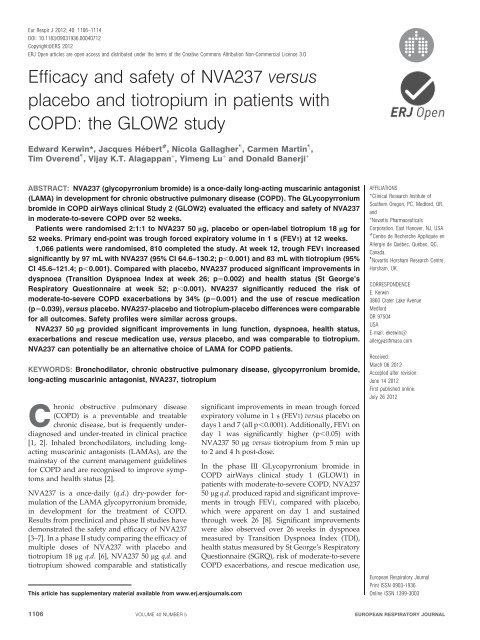

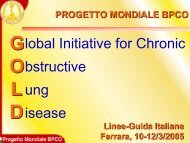
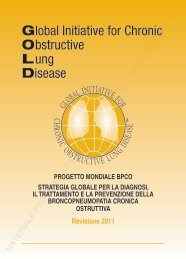
![Di Bari [NO].pdf - GOLD](https://img.yumpu.com/21544924/1/190x143/di-bari-nopdf-gold.jpg?quality=85)

